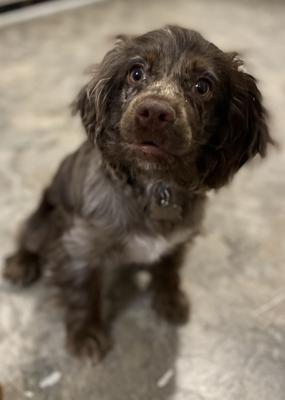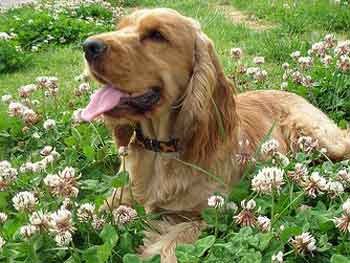- Home
- Cocker Spaniel training
- Separation anxiety in dogs
Separation Anxiety In Dogs
Separation anxiety in dogs and puppies is quite common. Dogs and puppies often suffer anxiety because they don't like being left on their own for very long.
Understand more about separation distress, what causes it, and what signs to look. Learn how to deal with your dog's separation anxiety and help to make him a happier Spaniel!
Dog Separation Anxiety: What Exactly Is It?
Separation anxiety in dogs (also known as separation distress) is fairly common in the Cocker world as Spaniels don't like to be left on their own and often become anxious or stressed when their owner leaves the house.
Sometimes, even the sight of you picking up your coat or house keys is enough to trigger your dog's anxiety! Unfortunately this stress can cause your pet to do considerable damage to your home and can lead to behavioural problems.
I suspect if you have a dog with separation anxiety you'll already know it!
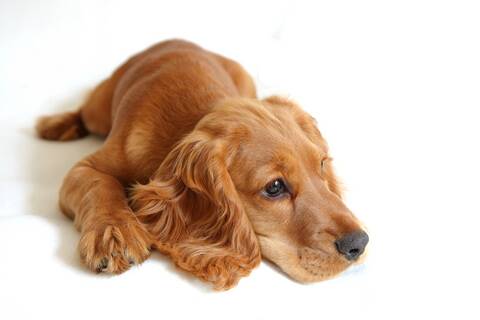 Just Chillin'
Just Chillin'If
your Cocker usually follows you around the house all day, (even to the
toilet!) and greets you like a crazed Tasmanian Devil on your return,
despite the fact that you've only been gone a minute, or you were only
in the next room, chances are he's displaying separation anxiety!
Thankfully it can be remedied; you can learn how to treat your dog's separation anxiety and minimize any stress your pet may feel.
Unfortunately, an owner's inability to manage their dog's anxiety is one of the main reasons why many Cockers end up in a rescue or adoption centre, but all it takes is an understanding of the problem and a little patience.
Before we look at typical symptoms of separation anxiety in dogs, let's have a look at some of the common causes.
Main Causes of Separation Anxiety in Dogs
There are many things that can cause your Cocker Spaniel to become anxious or stressed, for example:
- Boredom can trigger and can increase separation anxiety in dogs.
- Too much attention from us and our family during the day.
- Poor socialization skills can often result in separation anxiety in dogs and puppies, making them over-dependent on us.
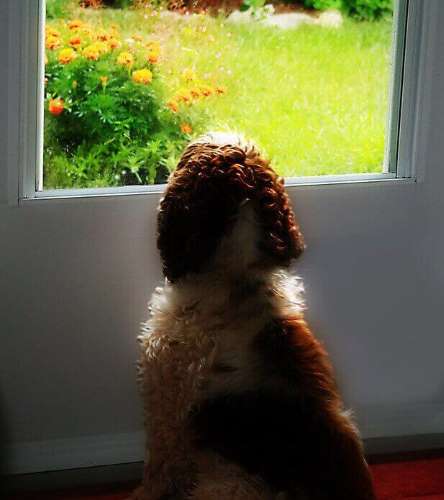 Where's my Mum?
Where's my Mum?- Confining your Cocker Spaniel for too long, for example; in his crate or tied in the yard, can cause him considerable anxiety.
It's best if your dog is not confined for longer than 5 hours maximum. If you do have to leave him for longer than 5 hours, make sure he has access to plenty of fresh drinking water and is safe and warm. - Owner behaviour - making a fuss before you leave and when you return will tend to over-excite your Cocker Spaniel.
- Under trained and disobedient dogs - sometimes the problem may not be separation anxiety but simply your dog behaving badly.
If you think your dog may be misbehaving, try reinforcing these puppy obedience training commands and be sure to correct him every time he's 'naughty'. - Mistreatment
in a 'past life' may be at the root of separation anxiety in dogs,
perhaps he was an abandoned dog or came from a rescue centre?
Also bear in mind that whilst in the rescue centre he would have been used to having other dogs and their carers around him. Once adopted, he suddenly finds himself in a loving home, but is sometimes left on his own.
In this instance, being alone is probably new to him and he may worry that you won't come back which may be very scary for him. - Genetics - it may simply be that he's a nervous, anxious dog.
Symptoms of Separation Anxiety in Dogs
There are many symptoms of separation distress as follows:
Barking, Whining and Pacing
If your Cocker Spaniel whines or cries when you're not around, he's showing anxiety because he doesn't know when, or even if, you're coming back. He won't understand that you've just popped out for a little while and that you will return.
He may feel frightened, unhappy and alone and his distress may be so severe that it panics him.
Feeling miserable like this often causes barking, whimpering or whining; all common symptoms of separation anxiety in dogs. In some cases you may see your dog pacing back and forth.
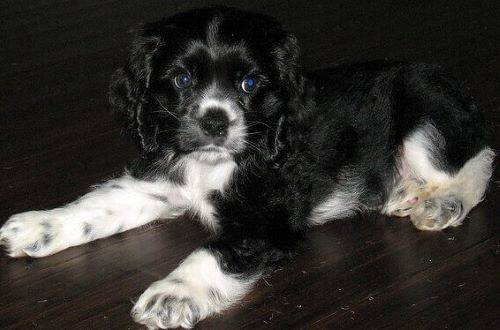 I don't like it when my Mum leaves me alone
I don't like it when my Mum leaves me aloneSome Cockers will start barking even before their owners have left (as they notice the signs of their owners leaving the house) and may not stop barking until they return, others may not bark until after an hour or so of being left alone (past the boredom threshold).
It may be a good idea to check with your neighbours, I'm sure they'll let you know if your dog is barking while you're away.
Max barks when visitors arrive, but once I've acknowledged his barking, he stops. I don't really have a problem with that. He's turned out to be quite a good guard dog - at least, behind closed doors!
Excessive barking isn't good for your dog, for you or for your neighbours' sanity and continued barking can be a real problem. The sooner it's stopped, the better for all concerned.
Destructive Behaviour
In serious cases of separation anxiety our dogs sometimes can cause mass destruction (I'm not exaggerating!) by chewing everything in sight.
Some anxious dogs will chew anything; shoes, edges of carpets and rugs, cupboard doors, the sofa, curtains, blinds, etc. I fact, they can easily destroy your home if left alone in this state for a couple of hours.
If your dog chews when he's left alone you can minimize any damage to your home by confining him to one room. A utility room or kitchen is often a good choice in cases like this (not much furniture to chew). Just remember to make him comfortable leave him with a bowl of fresh drinking water.
If your pet is into munching why not take a look at these 10 top tips to help stop your puppy chomping his way through your home?
Digging or Scratching
Digging and scratching at floors, walls, or doors is a classic sign of separation anxiety in dogs.
If your Cocker Spaniel emulates digging it's because he's trying to escape (literally dig his way out) to re-unite himself with his pack.
If
the scratching and digging action is quite severe it can result in not
only damage to your home, but also torn and bleeding claws. Thankfully, we've not had bleeding claws, but we have had a new leather sofa almost destroyed with claw marks!
Separation Anxiety In Dogs And Toilet Behavior
Separation anxiety in dogs may sometimes cause your Cocker to poop or pee in your home while you're away and if he's really distressed, he may throw up.
So you could find a bit of a mess in the kitchen on your return!
Not quite the welcome home you had in mind, is it?
Severe Excitement On Your Return
Extreme excitement (from your dog, that is) on your return home is another classic symptom of separation anxiety in dogs.
Picture the scene - you creep silently towards the front door, you're standing ever so quietly outside the door, house-keys in your hand, but even as that key enters the lock your dog will be at the door before you know it! In fact, he was probably there, waiting, 5 minutes before you arrived!
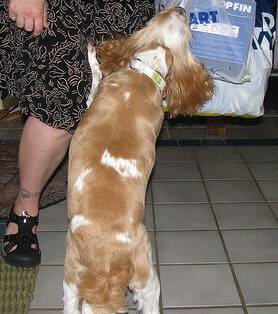 I've only been out for 20 minutes!
I've only been out for 20 minutes!How do they do that?
Just hearing you outside the door may be enough to set him off digging, scratching, barking, whining, or spinning with uncontrollable excitement.
And as soon
as you open the door he'll leap at you, almost uncontrollably, even if
he's well-trained and wouldn't normally jump up and he may dash around the room like a crazed Tasmanian Devil until he's almost exhausted!
Your Cocker Refuses To Eat Or Drink
Your Cocker Spaniel may be so upset about being left alone, that he refuses to eat or drink while you're away.
How To Remedy Separation Anxiety In Dogs
You'll be pleased to hear that whilst you may not be able to remove the problem altogether, you can certainly help to manage your dog's anxiety at being left alone, for example:
- Take him for a long walk to tire him out before you leave;
- Feed him, or leave him with a frozen treat to keep him occupied;
- Leave the radio on for him;
- Leave him with a few safe toys to play with;
- Ask a neighbour to pop in for 30 minutes while you're out;
Don't ever punish your dog for his anxious behaviour - he can't help it - instead, help him to relax.
Tire him out, make him feel comfortable and occupy his time and he may not even notice you're gone! You'll find a more detailed explanation of how you can help ease your dogs separation anxiety here.
Summary: Separation Distress
None of these above-mentioned behaviours are what I would call normal, but they are common symptoms of separation anxiety in dogs and they do need to be worked on as quickly as possible.
 Please don't go, Mum!
Please don't go, Mum!If you have a distressed or anxious dog whilst you're home his 'symptoms' may not be related to separation anxiety but could be the sign of an underlying illness, in this case it would be a good idea to take him to see his vet.
If on the other hand your dog is suffering severe separation anxiety, or you don't seem to be making any real progress, I recommend you consider consulting a qualified dog behaviour therapist.
If you have a puppy, regardless of whether or not he shows anxiety when he's left alone, this article on puppy separation anxiety is recommended ready!
Photo Credits for Separation Anxiety In Dogs:
1. Poutnik at https://www.dreamstime.com/stock-photography-english-cocker-spaniel-baby-dog-image8840862
2. Faith Goble at Flickr.com - https://www.flickr.com/photos/grafixer/4906972374
3. Mihir Samel at Flickr.com - https://www.flickr.com/photos/mihir_behind_the_lens/2668618048/in/photolist-54Pnb1
4. Visitor Photo
5. Raffi Asdourian at Flickr.com - https://www.flickr.com/photos/46958049@N00/4692832421

